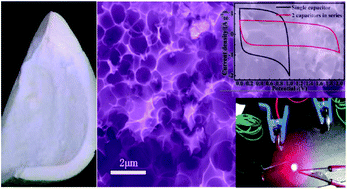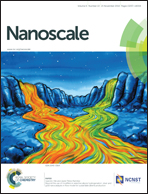A honeycomb-like porous carbon derived from pomelo peel for use in high-performance supercapacitors†
Abstract
A cost-effective approach to obtain electrode materials with excellent electrochemical performance is critical to the development of supercapacitors (SCs). Here we report the preparation of a three-dimensional (3D) honeycomb-like porous carbon (HLPC) by the simple carbonization of pomelo peel followed by KOH activation. Structural characterization indicates that the as-prepared HLPC with a high specific surface area (SSA) up to 2725 m2 g−1 is made up of interconnected microporous carbon walls. Chemical analysis shows that the HLPC is doped with nitrogen and also has oxygen-containing groups. Electrochemical measurements show that the HLPC not only exhibits a high specific capacitance of 342 F g−1 and 171 F cm−3 at 0.2 A g−1 but also shows considerable rate capability with a retention of 62% at 20 A g−1 as well as good cycling performance with 98% retention over 1000 cycles at 10 A g−1 in 6 M KOH. Furthermore, an as-fabricated HLPC-based symmetric SC device delivers a maximum energy density of ∼9.4 Wh kg−1 in the KOH electrolyte. Moreover, the outstanding cycling stability (only 2% capacitance decay over 1000 cycles at 5 A g−1) of the SC device makes it promising for use in a high-performance electrochemical energy system.


 Please wait while we load your content...
Please wait while we load your content...